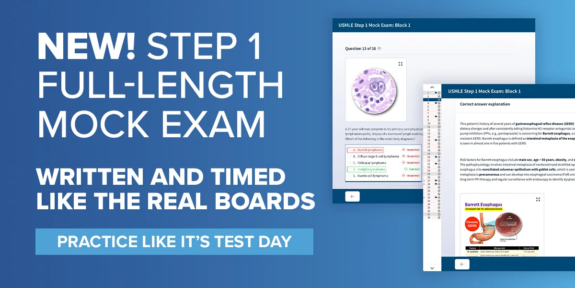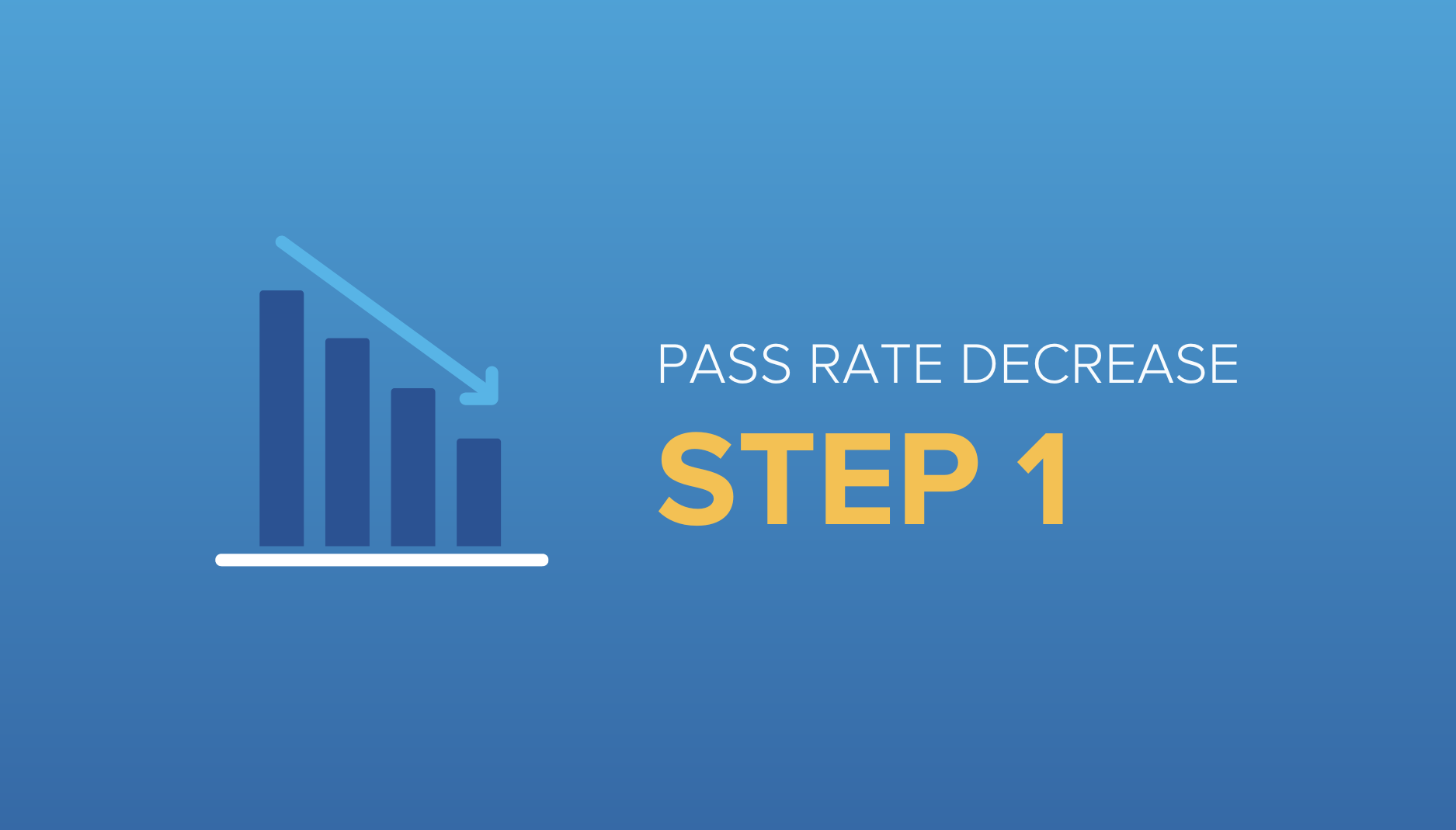In recent years, the role Step 1 of the United States Medical Licensing Exam (USMLE) plays in the residency application process has changed. When it transitioned from a scored assessment to a pass/fail test in January 2022, the change alleviated pressure to score as high as possible, and realigned the focus back to making sure students have the foundational scientific knowledge they need to take care of patients.
While well-intentioned, this change seems to have had an unintended consequence: the Step 1 pass rate is now decreasing. Needless to say, you don’t want to become a part of this unwelcome trend. Step 1 is still an important exam. and it’s to your advantage to pass it on the first attempt.
And we can help you do that! In this post we’re going to review some key stats about Step 1 and give you some tips that’ll help you put it in the rearview mirror. Read on to learn more about what’s happening with the Step 1 pass rate, and how to make sure you pass on exam day.
Downward Trends in the USMLE Step 1 Pass Rate
While the stress to maximize your score may be gone, the USMLE Step 1 still poses a big challenge to test-takers. In fact, the Step 1 pass rates have actually declined every year since its transition to pass/fail.
Here are the most recent Step 1 pass rates among first-time test-takers:
MD:
91% in 2022
90% in 2023
89% in 2024
DO:
89% in 2022
86% in 2023
86% in 2024
The reason for this decline in the Step 1 pass rate is likely multifactorial. Let’s look at a couple of reasons it may be happening:
Why There Has Been a Decrease in the Step 1 Pass Rate?
1. The Threshold for Passing
First, the threshold for passing has increased. On the previous three-digit score scale, the cutoff to pass the exam was 194. Though these three-digit scores are no longer reported, the passing cutoff has increased to what would have been 196 before. Understandably, as the minimum expectations increased, the rate at which students pass has slightly fallen.
2. Difference in Approaching the Exam
Beyond that, another possible reason for this decline in the Step 1 pass rate is an evolution in how students approach the test. Without the historical incentive to score as highly as possible, test-takers may not be as motivated to study for Step 1. In other words, the perception that passing is an easy hurdle to scale and performance beyond that has minimal return may diminish the drive to study.
Blueprint Med School Study Planner data shows that students are also answering fewer practice questions to study for Step 1 now that it’s pass/fail. When the exam was still graded, the average student completed 2,000 practice questions to study for Step 1 in 2019—compared to an average of 1,500 practice questions after the exam went pass/fail.
While the cause for the decline in the Step 1 pass rate isn’t entirely clear, one thing is certain: students need to properly prepare for the exam. Even as a pass/fail test, the USMLE is as important as ever in obtaining residency and progressing forward in medicine.
The Importance of Passing Step 1
Residencies will not receive any comparative statistics about how you performed other than whether you passed. However, should you fail the exam, the failed attempt will be included in the score transcript attached to your application. While residency programs may have no way of knowing whether a passing score today would have reflected a 196 or a 270 in the past, they do know that a failing score would reflect less than a 196. Therefore, you should prioritize taking the exam once and passing on the first attempt.
Furthermore, the content on Step 1 overlaps in many ways with the material on the USMLE Step 2 CK, a test that is still scored on a three-digit scale and considered in applications. It even shows up on the many standardized shelf exams for different clinical rotations and the USMLE Step 3. This basic science foundation that underlies clinical medicine informs many of the management decisions that arise in patient care. Making sure you understand the mechanisms of diseases and treatments as tested on the Step 1 exam will lead to success on Step 2 CK and beyond.
That being said, don’t despair if you’ve failed the exam! While it can feel discouraging, this certainly doesn’t mean the end of your medical career. Discuss your circumstances with your advisers to identify a timeline for retaking the test and make a new study plan to ensure you pass on your next attempt. You will have opportunities in the future like your clinical rotations, shelf examinations, and of course the USMLE Step 2 CK to demonstrate your resilience.
How to Pass the USMLE Step 1
Now let’s look at what you can do to ensure you pass Step 1 on the first attempt! We recommend the following:
1. Establish a sensible study timeline
The first step in your approach to Step 1 is developing a reasonable timeline. When you should take the exam is a highly individualized decision. However, you should consider where your starting point is, how much time you can commit to studying, and what deadlines you have to meet to advance through medical school in a timely manner.
Once you settle on an approximate exam date, register with the National Board of Medical Examiners (NBME) to obtain a scheduling permit and reserve a date. Having your exam scheduled as opposed to open-ended will motivate you and minimize procrastination.The backbone of your study plan should center on practice questions. There are various options for Step 1 question banks that have thousands of questions covering high-yield exam content. Working through one of these banks during your dedicated study period is a crucial component of any successful study plan.

Get ready to pass with Blueprint Med’s Step 1 Practice Bundle—test your knowledge with 2 full-length USMLE mock exams and a 500-question Qbank!
Beyond questions, you should also layer in quality reference text(s). In particular, First Aid for the USMLE Step 1 is practically a one-stop shop for high-yield content. To review more complex new concepts like cardiac or renal physiology, consider using other textbooks and video services like Pathoma and Boards and Beyond which take a deeper dive into certain topics. Importantly, any resources beyond questions are supplemental and should take up only a minority of your time.
2. Use practice tests to guide the timing of your exam
As we mentioned, one of the single most important tools to ensure you pass Step 1 is to make use of practice questions. More specifically, practice tests can be an incredibly effective way to prepare you for USMLE content, how to answer USMLE-style questions, and overall master your exam timing.
Currently, the NBME publishes six Clinical Basic Science Self-Assessments (CBSSAs) on their website for purchase, in addition to a set of 120 retired USMLE questions. Beyond that, certain question banks like UWorld and AMBOSS come with self-assessments that can serve as practice tests. You should aim to pass multiple practice exams, ideally three or more with a comfortable margin above the passing threshold.
3. Set your daily schedule with study planners
Translating all of this into a daily routine can feel overwhelming. To sort through everything, create a study planner to break down what you need to finish on a day-by-day basis. This can be as simple as a spreadsheet or a physical day planner, but if you’re looking for an online resource that automates much of the process, consider a smart study planner like Blueprint’s Med School Study Planner. Simply input the resources and practice tests you plan on using and the intuitive interface will make a checklist of tasks for you to do each day.
Final Thoughts
Remember: Just because Step 1 is pass/fail doesn’t mean that it no longer matters. On the contrary, this is all the more important as the passing threshold rises.
The Step 1 pass rate is decreasing. Don’t become part of this unwelcome trend! Committing to a study plan will be key to passing this exam. Start with a quality question bank, layer in supplemental resources like textbooks and videos, and finally take and pass multiple practice tests before sitting for the real exam.
With the right amount of preparation, you’ll pass on test day and set yourself up for success throughout the rest of medical school, on your later board exams, and in your residency applications.





